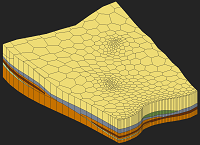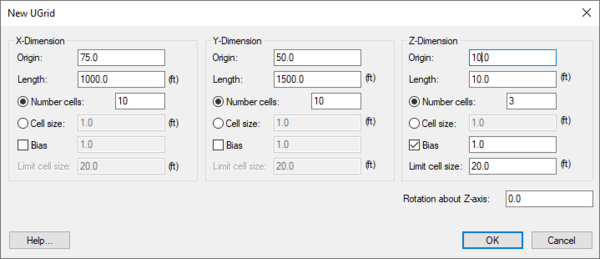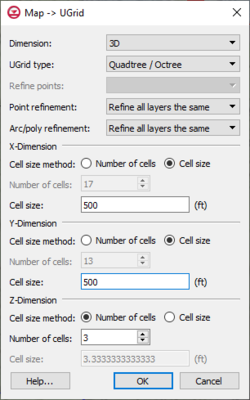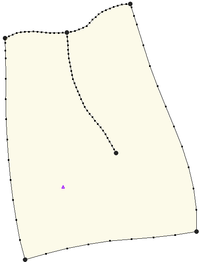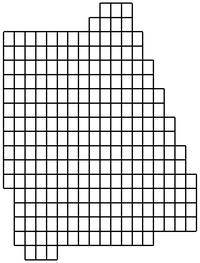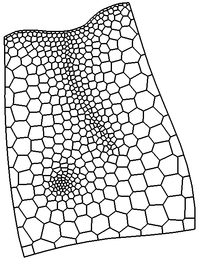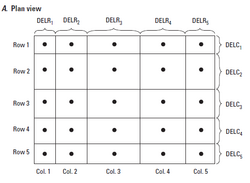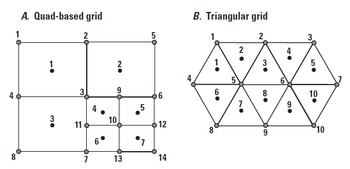GMS:Creating and Editing UGrids: Difference between revisions
From XMS Wiki
Jump to navigationJump to search
| (10 intermediate revisions by 2 users not shown) | |||
| Line 11: | Line 11: | ||
==Map → UGrid== | ==Map → UGrid== | ||
The '''Map → UGrid''' command creates a UGrid from feature objects. It can be found in the ''Feature Objects'' menu, in the Map toolbar, and in some pop-up menus when right-clicking on items in the [[GMS:Project Explorer|Project Explorer]] (Coverage, Grid Frame). The command opens the '' | The '''Map → UGrid''' command creates a UGrid from feature objects. It can be found in the ''Feature Objects'' menu, in the Map toolbar, and in some pop-up menus when right-clicking on items in the [[GMS:Project Explorer|Project Explorer]] (Coverage, Grid Frame). The command opens the ''Map → UGrid'' dialog. | ||
[[Image:DialogCreateUGrid.png|thumb|right|250 px|Map → UGrid dialog.]] | [[Image:DialogCreateUGrid.png|thumb|right|250 px|Map → UGrid dialog.]] | ||
| Line 58: | Line 58: | ||
==3D → 2D== | ==3D → 2D== | ||
If the UGrid has 3D cells, this command brings up a dialog asking for the layer number from which a UGrid consisting of 2D cells will be created. | If the UGrid has 3D cells, this command brings up a dialog asking for the layer number from which a UGrid consisting of 2D cells will be created. | ||
==Constraints== | ==Constraints== | ||
A UGrid is a general purpose unstructured grid that can have a variety of cell types. GMS applies some structure to unstructured grids in the form of "constraints" (previously called "UGrid Structure"). The UGrid's constraint determines the types of cells and the editing operations that are allowed and how they are performed on the UGrid. The constraint of a UGrid is shown in the ''UGrid Properties'' dialog. | A UGrid is a general purpose unstructured grid that can have a variety of cell types. GMS applies some structure to unstructured grids in the form of "constraints" (previously called "UGrid Structure"). The UGrid's constraint determines the types of cells and the editing operations that are allowed and how they are performed on the UGrid. The constraint of a UGrid is shown in the ''UGrid Properties'' dialog. | ||
* | *"Quadtree 2D" – Used for 2D grids that were either converted from a 2D or 3D grid or were created using as a Regular, Quadtree, or Nested UGrid. Cells can be refined but not deleted or created and cell boundaries cannot be moved. Points cannot be added, deleted, or moved. | ||
*''Voronoi'' – Used for grids created using Voronoi option in the ''Map → UGrid'' dialog. For the outer cells of a Voronoi UGrid the computational centroid of the cell is along the outer edge to maintain the right angle connection between cells when generating the MODFLOW UDIS package file. Cells cannot be refined or deleted or created and cell boundaries cannot be moved. Points cannot be added, deleted, or moved. | *"Quadtree 3D" – Used for 3D grids that were either converted from a 2D or 3D grid or were created using as a Regular, Quadtree, or Nested UGrid. Cells can be refined but not deleted or created and cell boundaries cannot be moved. Points cannot be added, deleted, or moved. | ||
* | <!--*''Voronoi'' – Used for grids created using Voronoi option in the ''Map → UGrid'' dialog. For the outer cells of a Voronoi UGrid the computational centroid of the cell is along the outer edge to maintain the right angle connection between cells when generating the MODFLOW UDIS package file. Cells cannot be refined or deleted or created and cell boundaries cannot be moved. Points cannot be added, deleted, or moved.--> | ||
* | *"Rectilinear 2D" – For a 2D grid. The row and column spacing in the grid can vary, but the row and column boundaries are straight. Each cell center or grid node can have a unique elevation. The grid can also be rotated about the Z axis if desired. Also, cells cannot be created or deleted or refined and, cell boundaries cannot be moved. Points cannot be added, deleted, or moved. | ||
* | *"Rectilinear 3D" – For a 3D grid. The row and column spacing in the grid can vary, but the row and column boundaries are straight. Each cell center or grid node can have a unique elevation. The grid can also be rotated about the Z axis if desired. Also, cells cannot be created or deleted or refined and, cell boundaries cannot be moved. Points cannot be added, deleted, or moved. | ||
*"2D" – Used for 2D surfaces such as a TIN, mesh, or simply as points without cells. This is the default when creating a new UGrid by clicking points in plan view, and when importing points from a text file and specifying "UGrid Points 2D". Points can be triangulated to form cells and cells can be deleted. Points can be added, deleted, and moved. | |||
*"3D" – Used for 3D surfaces such as a TIN, mesh, or simply as points without cells. This is the default when creating a new UGrid by clicking points in plan view, and when importing points from a text file and specifying "UGrid Points 3D". Points can be triangulated to form cells and cells can be deleted. Points can be added, deleted, and moved. | |||
*"None" – No constraint. Used for all other UGrids. Points can be triangulated to form cells and cells can be deleted. Points can be added, deleted, and moved. | |||
MODFLOW 6 will determine the discretization package based on the UGrid constraints. | |||
* The DIS package requires a rectilinear 3D UGrid. | |||
* The DISV package can work with any UGrid that is stacked. | |||
* The DISU package requires a non-stacked UGrid. The DISU package is not recommended for use. | |||
{|- | |||
|- | |||
|[[File:Rectilinear-grid.png|thumb|none|250 px|UGrid with rectilinear constraint]] | |||
|[[File:Disv-grid.png|thumb|none|350 px|UGrid examples]] | |||
|} | |||
==Cell Refinement== | ==Cell Refinement== | ||
UGrid cells can be refined by selecting the cells, right clicking on them, and selecting the ''Refine'' menu item. A new copy of the UGrid will generated with the selected cells refined. The cells will be refined based on the structure of the UGrid. For a UGrid with quad tree structure a cell is refined by adding an additional level of quadtree refinement. Voronoi structured UGrid cells can only be refined by permanently changing the grid structure to Unknown. For a UGrid with unknown structure, a 3D cell is refined by adding a node at the middle of each horizontal edge along with a new node at the center of the top and bottom faces. | UGrid cells can be refined by selecting the cells, right-clicking on them, and selecting the '''Refine''' menu item. A new copy of the UGrid will generated with the selected cells refined. The cells will be refined based on the structure of the UGrid. For a UGrid with quad tree structure a cell is refined by adding an additional level of quadtree refinement. Voronoi structured UGrid cells can only be refined by permanently changing the grid structure to Unknown. For a UGrid with unknown structure, a 3D cell is refined by adding a node at the middle of each horizontal edge along with a new node at the center of the top and bottom faces. | ||
==Deleting Points and Cells== | ==Deleting Points and Cells== | ||
| Line 89: | Line 95: | ||
A UGrid can be divided into multiple layers using the '''Split Layer''' command. Use the '''Select Cells''' tool to right-click on a cell in the UGrid and select the '''Split Layer''' command. Currently, GMS will duplicate the existing UGrid and create the new layer(s) on the duplicate UGrid. To split UGrid layers, the UGrid must be a stacked UGrid where all layers are identical. Layers cannot be split on UGrids containing pinch-outs. | A UGrid can be divided into multiple layers using the '''Split Layer''' command. Use the '''Select Cells''' tool to right-click on a cell in the UGrid and select the '''Split Layer''' command. Currently, GMS will duplicate the existing UGrid and create the new layer(s) on the duplicate UGrid. To split UGrid layers, the UGrid must be a stacked UGrid where all layers are identical. Layers cannot be split on UGrids containing pinch-outs. | ||
==UGrid Structure, Prior to GMS 10.2== | |||
A UGrid can keep track of the geometric structure it was generated from. The structure can control the editing operations that are allowed and how they are performed on the UGrid. The structure of a UGrid is shown in the UGrid Properties dialog. | |||
*''Quadtree'' structure is used for grids that were either converted from a 2D or 3D grid or were created using as a Regular, Quadtree, or Nested UGrid. | |||
*''Voronoi'' structure is used for grids created using Voronoi option in the ''Map → UGrid'' dialog. For the outer cells of a Voronoi UGrid the computational centroid of the cell is along the outer edge to maintain the right angle connection between cells when generating the MODFLOW UDIS package file. | |||
*''Unknown'' structure is used for all other UGrids. | |||
{{Navbox GMS}} | {{Navbox GMS}} | ||
